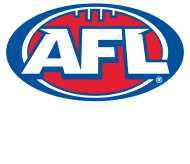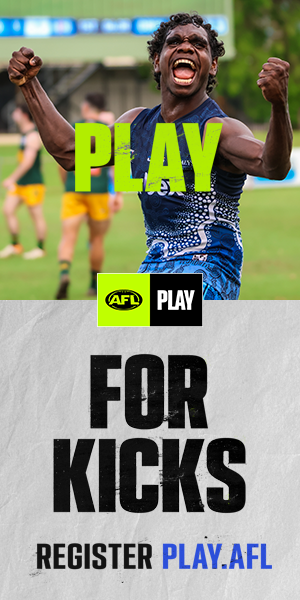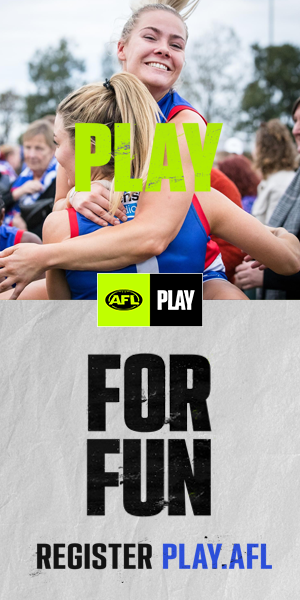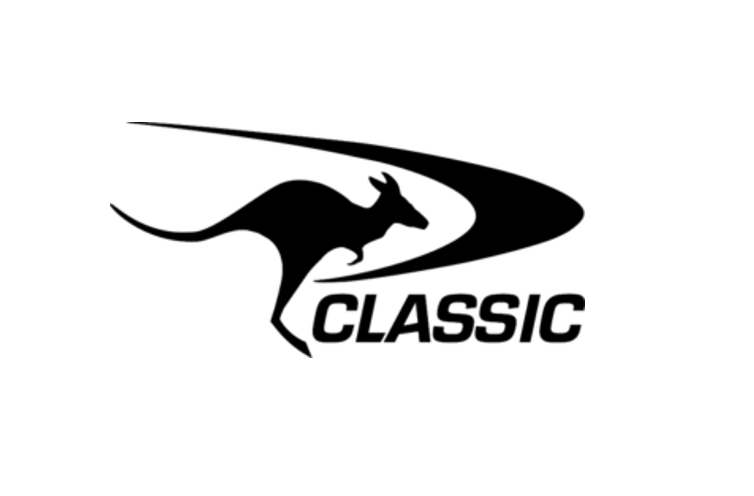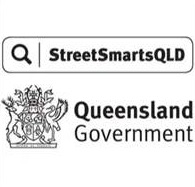In 1983-84-85 the ‘Mighty Maroons’ played nine games that changed the face of Queensland football forever. Three years in a row they won a round-robin series against NSW, ACT and Tasmania to clinch the ultimate reward – an AFL side of their own.
The Brisbane Bears were effectively ‘born’ after the state side, coached by Norm Dare (1983-84) and Laurie Pendrick (1985) and captained by Mick Nolan (1983), Gary Maddison (1984) and Kevin O’Keeffe (1985), confirmed the credentials of the Sunshine State.
The code had made massive strides north of the Tweed River and in October 1986, representatives of the 12 existing clubs in the then VFL voted to admit teams from Brisbane and Perth. It was the first alteration to the competition since 1925, as the Brisbane Bears and the West Coast Eagles were born.
The role of the state side in the lead-up to this monumental decision should never be under-estimated. It was critical, adding a senior layer to an overall platform built on a burgeoning explosion in the game’s popularity in Queensland at grassroots levels.
Fifty-six players in total, homegrown Queenslanders, relocated AFL stars and others who identified the exciting growth of the game in the Sunshine State, combined to do the job under the Dare, Pendrick, Nolan, Maddison and O’Keeffe and a shrewd off-field team that included selectors Bruce Burgoyne (chairman), Alan Piper, Andrew Ireland and Brian Jeffery and QAFL general manager Ken Murphy.
They won eight of nine games, beating NSW and Tasmania three times and losing by six points to ACT in Canberra in 1984, and clinched the hat-trick with an extraordinary 96-point win over Tasmania in Brisbane in 1985.
Among a mountain of great individual stories was the discovery of one of the all-time AFL greats. Jason Dunstall, in his first full season with Coorparoo at 19, made his state debut for the Maroons before a 1985 move to Hawthorn, where he played 269 games and kicked 1,254 goals to rank second on the all-time AFL goals list.
The glorious triple triumph of 1983-84-85 was the culmination of a roller-coaster ride through an era in which Queensland was regarded the game’s senior administrators as clearly a ‘division two’ state behind Victoria, South Australia, Western Australia, and Tasmania.
It started when the Maroons, coached by Terry Moule and captained by Bill Ryan, won the division two title for the first time in Sydney in 1974 with wins over NSW and ACT, with and posted an historic 22-point win over Tasmania at the Gabba in 1975 – their first win over a ‘division one’ side. They were two great years and earned the 1974-75 team a place in the Queensland Football Hall of Fame.
In 1976 a five-point win over Canberra at the Gabba was followed by a 46-point loss to Tasmania at North Hobart Oval, and in 1977 they lost to Port Melbourne by 31 points at Norwood Oval in Adelaide, but beat the VFA at the Gabba by seven points.
In 1978 they beat Tasmania by 22 points and the VFA by five goals, both at the Gabba, but lost by six goals to Port Melbourne at Lakeside Oval in Melbourne. Two mid-season hidings in 1979 – by 133 points to South Australia at the Gabba and by 156 points to the VFA in Melbourne – slowed the momentum before a good showing at the end-of-season State of Origin Carnival in Perth, where a side coached by Warren Roper and captained by Barry Clarke lost the division one ‘qualifier’ to Tasmania by 32 points but beat Canberra by 31 points to win the division two title.
The mixed results continued in 1980 after Norm Dare took over as coach – a memorable 38-point March win over Tasmania in Ulverstone – their first triumph over Tasmania in Tasmania – before a nine-goal loss to Footscray at Windsor Park the following week, a shattering 198-point loss to South Australia at Football Park in Adelaide in May and an 80-point loss to Victoria under Origin conditions at the Gabba in July.
In 1981, with Dare as coach and Frank Gumbleton captain, the Maroons copped a 131-point Origin hiding from Victoria at the Gabba, and in 1982 under captain-coach Gumbleton they beat NSW by 84 points at Chelmer but lost by 45 points to Canberra in Canberra and by 15 points to Tasmania at Chelmer. A 39-point Gabba win over Canberra at the Gabba in the Commonwealth Games Exhibition Match eased the pressures, but it had been up and down for long enough.
It had been a period in which a wave of ex-AFL players like Dare had moved to Queensland to play and/or coach, including Gumbleton, Mick Nolan, John Blair and Mike Woolnough (1981), Peter Morrison and Bob Bell (1982), Alex Jesaulenko, John Rantall, Carl Ditterich, Pat Wellington and Barry Grinter (1983) and Ronnie Wearmouth (1984).
The game was on the move, but it needed a flagship team to fully capitalise.
Dare, premiership coach at Kedron in 1980 in his first season in Queensland, had left the premier competition in 1982 to move to Southport. But when Southport and Sherwood joined an expanded QAFL in 1983 the former Fitzroy player, later to be named coach of the Queensland Team of the Century, took back the reins of the Maroons to start the golden run.
It all began on Sunday 24 April. The team was scheduled to assemble at Eagle Farm airport at 5.30am for a hit-and-run mission to the SCG. If that wasn’t unsettling enough the bumpy flight south certainly was.
Players were still being strapped as the team gathered to run out to play NSW in a curtain-raiser to the Swans v St.Kilda AFL clash in which a 17-year-old Tony Lockett would play his second AFL game and Trevor Barker his 150th for the Saints alongside the ever-colorful Mark Jackson, who would kick 10 goals in a side beaten by 23 points.
Not surprisingly, NSW led 8-17 to 7-4 at halftime and should have had it won. But after stirring addresses from Dare and captain Mick Nolan, a premiership ruckman at North Melbourne in 1985, the Maroons stormed back and kicked seven goals in the final term to 20-16 (136) to 17-20 (122).
Robbie Dickfos, still only 19, was uncanny at half forward in his senior interstate debut and kicked five goals including the go-ahead goal to be judged best afield. Other standouts included John Blair, superb at centre half back, Nolan, Gary Maddison, who was swung into the centre at halftime, Peter Morrison, Rob Magarey, Steve Russ and Don Smith, who returned to State football after a two-year absence.
Queensland welcomed the inclusion of Zane Taylor, back from a stint with Geelong, for the second game against the ACT at Windsor Park on 15 May but lost Blair to injury. A huge responsibility fell to Don Smith, he was elevated to the vice-captaincy and started in the unfamiliar role at centre half forward, which had been a problem against NSW.
As if to say “what problem?” Smith, with a new-found enthusiasm for state football that reflected the QAFL’s new-found commitment to it, kicked the first goal 30 seconds into the game against an ACT side which included the ever-colorful Phil Carman.
The home side led by two points at half-time and were disappointed. So much so that it dominated completely in the second half to win 20-15 (135) to 15-15 (107).
Tony Beckett, brilliant in his second game for the State on the wing, edged out Smith, who kicked four goals, for best afield honors. Maddison, Russ, rover Marc Housley, back pocket Graham Adams and Dale Woodhall, wearing white boots, were other standouts with the unassuming Magarey, who shut down a threatening Carman when swung onto him in the second term.
This set up a 4 June decider against Tasmania in Hobart, for which the selectors would make a brave but brilliant choice to include a player who just two weeks earlier had joined Coorparoo. Ex-Fitzroy star Kevin O’Keeffe, destined to play a critical role in the 1983-84-85 hat-trick, slotted in beautifully in defence after Blair was again ruled unfit.
A crowd of 10,000-plus at North Hobart Oval wouldn’t hear of a Tasmanian loss, but Dare, ever the master tactician, pulled a serious of match-winning changes, shifting Zane Taylor back to his rightful spot at half back, deploying Southport ruckman Peter Guy at centre half back, using the ever-reliable Magarey on dangerman Wayne Fox, and slotting John Farrer into the ruck with the ever-inspirational Nolan.
Queensland led by two points at quarter-time and 19 points at half-time despite wayward kicking. But it was a long way from over. Tasmania cut the deficit to 10 points at the last change.
Twice Tasmania hit the front in the final term but twice Queensland answered. And when Dickfos soared above a pack to pull down a screamer and slot the winning goal amid frantic hissing and booing from the locals, the pride in the Maroons jumper was enormous. They won 12-24 (96) to 13-23 (101) to become the first team to win the Escort Shield undefeated.
It was new-look Queensland team that set itself to defend the title after a pre-season practice match against Collingwood and a super-brave showing in a nine-point loss to St.Kilda. Gary Maddison took over as captain from Nolan, who had missed the early games but returned for the tri-state series, which was to begin against NSW at Windsor Park on 29 April. Terry O’Neill, a 101-game AFL player at South Melbourne and Fitzroy who had joined Coorparoo, was a key inclusion and Gavin Excel, a Carlton Reserves player, an inspired selection after one game for Southport. Also making their senior debut for Queensland were Wilston-Grange 17-year-old Scott McIvor and Coorparoo 18-year-old Michael Gibson.
NSW, the supposed ‘’easybeats” of the competition, proved anything but when they led 9-7 to 8-8 at halftime to bring out the best from the Queenslanders. They kicked 6-3 to 3-2 against the wind in the third quarter and 11-3 to 1-0 in the final stanza for a 26-13 (167) to 12-11 (83) victory.
Nolan, 33 years old and playing above his 113kg and 195cm frame, played like a young man in perhaps his best performance in a Queensland jumper. Memories of a best afield Nolan chasing a fleet-footed NSW rover 60m down the wing to force an error that led to a Maroons goal were unforgettable.
Maddison, who relished the representative arena, and Zane Taylor, usually a ruck-rover, were similarly outstanding, while O’Keeffe, O’Neill, Gibson, Magarey and Russ were impassable in defence. Peter Morrison was dangerous at half forward, State debutant David Pie kicked four goals in the final term for a match haul of eight, and Exell, who crashed heavily into the fence in the first term, recovered to kick five goals.
On to Canberra and the 27 May clash with the ACT. On a beautiful afternoon, Queensland always looked the better side, but it didn’t show on the scoreboard. The lead changed seven times before the visitors, without the same commitment as game one, took a 12-9 to 11-6 lead to halftime.
When Exell and Pie kicked the first two goals of the final quarter to put Queensland 20 points up all looked like it would be OK, but it wasn’t. The ACT got a steadier and then kicked three goals in the last five minutes to win 15-10 (100) to 14-10 (94).
Coach Dare gave his players a 15-minute dressing down behind closed doors after the match and said later, “we wanted to be a pretty team rather than an effective team – we were not prepared to do the hard things required to win hard games.”
O’Neill beat three opponents at fullback to be judged Queensland’s best from O’Keeffe and Russ in defence, wingman Beckett and football journeyman Peter Filler, who made an eye-catching state debut at centre half forward.
It was a sorry Queensland camp, but all was not lost. On the same day, at a muddy Erskinville Oval in Sydney, NSW kicked five goals in the last quarter in going down to Tasmania by just three goals, leaving the percentages of Queensland and Tasmania almost level. The calculators came out and it was confirmed that a win over Tasmania in Hobart on 30 June could still give them the title.
Preparation for the game against Tasmania began on the day of the game against the ACT, when Queensland selector Andrew Ireland had taken on scouting duties, flying to Sydney to watch the NSW-Tasmania game. His detailed report on the Tasmanian players was to prove critical.
The Maroons suffered a crucial blow in the lead-up to the “grand final” when Zane Taylor was declared unfit. Gary Maddison and Peter Filler were under a cloud as a 22-man party flew south, and only after a run in Hobart, were they declared fit, and Laurie Pendrick and Brendan McMullen were omitted from squad.
Still, the selectors made six changes to the side which had lost to NSW. Dunstall, who been setting the QAFL competition alight with Coorparoo, was the big inclusion at the expense of the unlucky Pie. Rod Lawrie, a member of the victorious 1983 side, was recalled as Don Smith, Peter Guy and Sel Short returned from injury. Sherwood forward Alan Giffard also was included for his interstate debut.
It was a tricky situation. Queensland needed only to beat Tasmania to finish ahead of them on percentages, but a close finish in a high-scoring match could give the title to ACT. If the Maroons’ winning score was 90 or less a one-point would suffice, but as the scores increased so did the necessary margin. At 100 it was four points, at 110 it six points, at 120 it was eight, at 130 it was 11, at 140 it was 13, and at 150 it was 15.
On a fine, cool afternoon at North Hobart Oval, in front of a wildly parochial crowd of 10,000-plus, the Maroons produced their very best in what Dare describes as “a wonderful team performance”.
They grabbed the upper hand from the first bounce, but it was a tight, hard contest throughout. It was one goal to the visitors at halftime and 14 points at three-quarter time before four quick goals saw them skip 33 points clear. Two late Tasmanian goals left the final scoreline 16-15 (111) to 13-12 (90) – enough to give Queensland the Shield by 7.22%.
With Queensland, ACT and Tasmania each recording two wins, the Maroons’ percentage of 136.99 edged out ACT’s 129.77 and Tasmania’s 119.72. Effectively, it was a 15-point win.
Armed with the scouting report from Ireland, a former Collingwood AFL player who would later go on to be an AFL premiership CEO with the Brisbane Lions and the Sydney Swans, coach Dare and his brainstrust pulled a series of surprise positional selections to stunning effect, shutting down the Tasmanian dangermen beautifully.
Lawrie and Steve Russ tagged rovers Danny Ling and Scott Wade, while Blair moved from his customary position at centre half back onto the ball and later in the centre, and Maddison and Housley played as ruck-rovers.
Magarey, the Maroons’ equivalent of the silent assassin, played on Tasmania’s gun forward Wayne Fox, who had kicked nine goals in each of his two previous Shield matches. Quietly spoken and humble beyond humble, even Magarey might have had a sneaky smile when Fox was ‘dragged’ midway through the final term with one kick to his name.
Dare said, “We tried a few things that were a little different and they came off. You can only do that when you have accurate information on the opposition players, and Andrew’s report was correct to the letter. It was a very important part of our planning.”
Wingman Beckett, who three years later would play for the Brisbane Bears, was a driving force all day and was named best afield. But it could just as easily have gone to Blair, who won a mountain of hard ball and used it to perfection, or centre half back O’Neill, who pulled countless overhead marks.
The backline stood up superbly under constant pressure. O’Keeffe, Magarey and Short provided the toughness to off-set the dash of O’Neill and Gibson, who only days earlier had signed with Fitzroy.
McIvor, Blair, and Beckett gave Queensland a winning centre line, while up forward Dunstall, later to be snapped up by Hawthorn, justified the selectors’ faith with four goals and a hand in numerous others, and half forwards Morrison and Exell were always dangerous.
Housley delivered one of his most brilliant displays in a long Queensland career, chipping in with three goals, while ruckmen Nolan and Guy dominated the tall-timber battles.
At an emotional after-match dinner, Don Smith, Queensland’s second most capped player behind John Stackpole with 21 State jumpers, announced his retirement from interstate football. So, too, did Nolan and Magarey.
Later, master coach Dare also stood down for family and work reasons. Pendrick, who three months later would spearhead Coorparoo to the 1984 QAFL flag, was appointed State coach for 1985 after he had filled an unofficial role as assistant coach in 1984.
Finally, captain Maddison, such a wonderful player in 19 games for Queensland from 1979-84, made the gut-wrenching announcement that at 26 he had been forced into retirement by a serious knee problem. If ever there was a Queensland player who should have played at AFL level and didn’t it was him.
It was a new-look Queensland team that rolled out in 1985 under new coach Pendrick, a spritely character from Wagga who was later identified as the “first football hero” of the great Wayne Carey.
Said Carey of Pendrick as NSW celebrated 140 years of football, “He was a very good player and a standout in Wagga. He played in the centre but could go forward and kick goals. He was tough and hard. Opposition fans hated him but North Wagga fans absolutely loved him.”
A former NSW captain-coach and a veteran of 400 games of football over more 20 years, Pendrick was an entirely different personality to Dare as he became just the fifth person to coach Queensland in 12 years, following Terry Moule (1974-76), Warren Roper (1977-79), Dare (1980-81, 1983-84) and Frank Gumbleton (1982).
Perhaps not as articulate or as detailed as Dare, he had his own way of captivating the enthusiasm of his players that was equally effective. He was a players’ coach, and around him he built a time of extraordinary spirit and loyalty. Filling the giant shoes of Dare, he did it spectacularly well.
Kevin O’Keeffe, who had settled into the Queensland program as if born to it, was named the new state captain but was injured in the first practice match against SANFL club West Torrens at Southport’s Owen Park which got the campaign for the renamed Foster’s Shield under way.
Tony Beckett, a consistently good player for Queensland, captained his state in games against Fitzroy at Carrara and Collingwood at Kedron’s Wren Oval ahead of a clash with St. Kilda, again at Kedron, that served as a qualifier for the national Foster’s Cup.
The results were mixed. A 50-point loss to Torrens for a side that included 12 debutants, a 104-point loss to Fitzroy, and an excellent showing against Collingwood that was better than the 24-point loss suggested. As much as that was more than good the 96-point loss to St. Kilda that followed was bad. Pendrick, suddenly in a no-win situation, had much to do.
O’Keeffe returned as captain as eight new players travelled to Wagga for the start of the Shield defence on 21 April among 14 changes from the side that had won the Shield 10 months earlier. To make things harder, NSW were no longer the easybeats after adding players from the Riverina to their talent pool.
Pendrick, who had won premierships with three different clubs in Wagga, was afforded a hero’s welcome as he arrived in enemy colors. The locals were ‘cocky’ as Queensland welcomed the inclusion of Zane Taylor, who had missed the warm-up matches through injury, and Marc Housley, who had been playing in Darwin. Brett Jones, a fringe player for what seemed like an eternity, was finally rewarded with his first state jumper.
Queensland deservedly won 21-15 (141) to 11-20 (86) but only in patches did they assert their superiority as ruck-rover Steve Russ, always a good state player, finished with a blood-splattered face from two heavy head knocks and the award for best afield.
Graham Adams, a super-disciplined Phil McGarry and the strong-marking O’Neill led the back half, while Blair, devastating in the first half, was the pick of the forwards with Brendan McMullen, who kicked five goals. Ricky Finch, too, was a valuable contributor.
Pendrick insisted it was “a good starting point”, and he was proved right when, on 12 May, Queensland producing a significantly improved performance to account for a classy ACT outfit 21-16 (142) to 18-22 (130) at Windsor Park.
The lead-up was not without drama when Glen Middlemiss, a 50-game player at Geelong and St. Kilda who had joined Southport in 1985, was dropped for disciplinary reasons on the Friday night before the Sunday game. He had pleaded ‘work commitments’ when he failed to front for a fitness test but fit or not, team management ruled he had not shown the commitment required. It was a statement that said much about a playing group which had built a strong internal respect and feeling.
Adams, who had finished the 1984 season in the Zillmere Reserves after an ill-fated trial in Perth in 1983, confirmed his career was back on track when judged best afield against the ACT from the ever-consistent Taylor and Beckett.
The versatility of the Maroons was crucial against ACT. After the early loss of Trevor Surman through injury, Pendrick swung Gary Becker to the unaccustomed role at centre half back. Phil Harper was similarly outstanding in a new role at centre forward, while Mark Frawley was brilliant in the centre. Jones and Housley were other standouts with four goals.
Even before the Queensland players reached the dressing rooms planning for the ‘grand final’ was underway, with League boss Ken Murphy announcing a two-day live-in camp at QEII before the Shield grand final at Windsor Park.
Going into camp the Queenslanders wore ‘Tassie-Buster’ t-shirts which featured a stylised map of Tasmania out of which appeared two ugly heads. The Apple Islanders were not happy, but after successive home losses to the Maroons in 1983-84, they had bigger things to worry about.
Sadly, Queensland lost vice-captain Beckett, Frawley, and Chris Melican to injury as, for the second year in a row, state team stalwart Peter Guy returned from injury for game three. Simon Hose was recalled as Brett Burden and Brett Allen debuted.
It was tipped to be close, and when Tasmania led 6-1 to 2-2 the home side had plenty to do. Especially with the home side reduced to 18 players, with Finch and Allen out of business. But do it, they did.
In one of the truly supreme showings the ‘Mighty Maroons’ kicked 7-5 to 2-2 in the second quarter to grab the lead, and despite Harper, Becker and Surman carrying injuries that normally might have put them out of the game, piled on an astonishing 14-10 to 1-2 in a second half cakewalk. It was 10-4 to nil in the final quarter as Queensland won by a record 96 points – 23-17 (155) to 9-5 (59) in front of the biggest crowd Queensland football had seen in years.
Harper, who had kicked four of Queensland’s first 10 goals to keep them in touch, epitomised the spirit in the side. Pendrick said, “Every time I asked him to come off he said he wasn’t going to miss that moment for anything.”
Nor was Glenn Goss, a Tasmanian branded ‘not good enough for State football’ by Tasmanian coach Garry Davidson. He came off the Queensland interchange bench at quarter-time to kick eight goals in a superb showing.
Flu victim Taylor won a photo-finish for best afield honors, forming an impassable half back line with O’Keeffe and O’Neill that repeatedly repelled any forward moves by the Tasmanians and returned them with interest. Such was their drive that O’Neill kicked two goals.
Hose, later to sign with the Sydney Swans for 1986, was superb on the wing, getting the better of four different opponents after a nervous start, and ruckman Guy was by far the best big man on the ground, repeatedly given Queensland first use of the ball from the centre.
Rovers Housley and McMullen put it all over their big-game Tasmanian opponents with the help of Burden, who shut down the explosive Scott Wade after quarter-time, and Phil McGarry was similarly effective on full forward Wayne Fox, who had dominated earlier games against NSW and ACT.
Pendrick had the last laugh on those who had criticised his decision to play the early season games against AFL opposition. “Those matches were vital in our preparation, and despite all the knocking we got I think we can have the last laugh. No coach could have asked more from 20 players. It was a fantastic performance,” he said.
Significantly, among the huge Windsor Park crowd was John Adams, who had been commissioned by the National Football League to investigate a proposed national competition. He was the man who would play a key role in deciding the future of Queensland football, and he could only have been totally impressed.
Only six members of the 1984 Shield grand final team had backed up in 1985 – O’Keeffe, O’Neill, Blair, Russ, Housley and Guy. Only O’Keeffe, Russ, Housley and Guy had completed the 1983-84-85 hat-trick. Only Russ and Housley had played in all nine games.
Members of the 1983, 84, 85 Queensland Team were:
Graham Adams
Brett Allan
Peter Bartlett
Gary Becker
Tony Beckett
John Blair
Kevin Brooks
Brett Burden
Robert Dickfos
Jason Dunstall
Gavin Exell
John Farrer
Peter Filler
Ricky Finch
Gary Fitzpatrick
Stephen Flintham
Mark Frawley
Michael Gibson
Alan Giffard
Glenn Goss
Peter Guy
Phil Harper
Simon Hose
Marc Housely
Brett Jones
Lynton Keighran
Rod Lawrie
Phil McGarry
Gavan McGuane
Ross McIvor
Scott McIvor
Brendan McMullen
Gary Maddison
Rob Magarey
Geoff Martin
Chris Melican
Les Millar
Peter Morrison
Haydn Muir
John Newton
Mick Nolan
Kevin O’Keeffe
Terry O’Neill
Jimmy Payne
David Pie
Steve Russ
Sel Short
Don Smith
Peter Stevenson
Paul Sullivan
Trevor Surman
John Taylor
Zane Taylor
Steve Thomson
Ian Wilson
Dale Woodhall
